Home
"The Ships"
featuring
Middelfart
Denmark
- a maritime community ? -
- and something about "Nordstjernen",
"Fionia Swan" and "Great Swan" -

"Gammel Havn" - "Old
Harbour"
- full of masts and
ships, - schooner "Nordboen" to the right -
(Photography by Karsten Petersen)
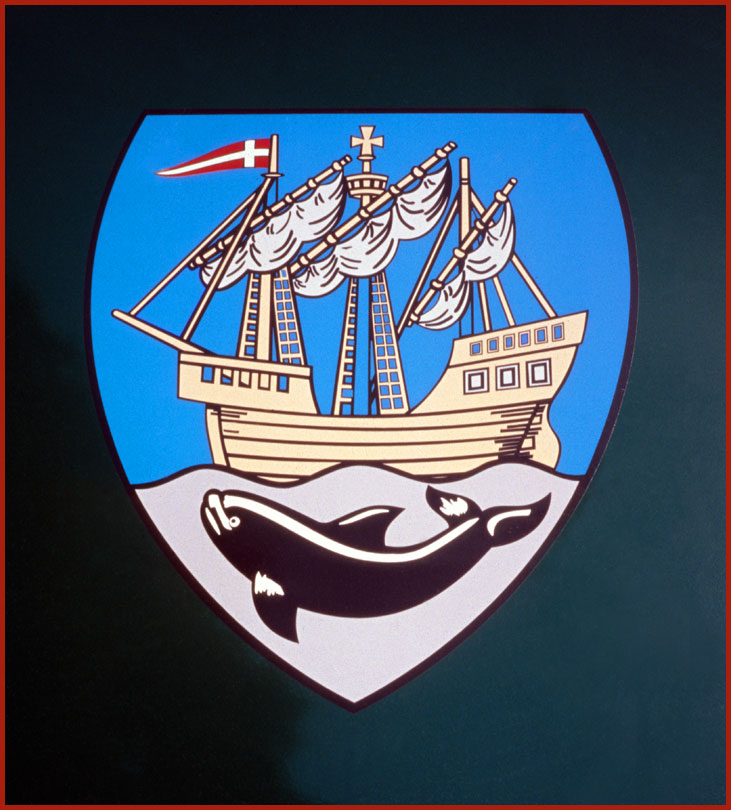
The Middelfart Logo from before
Jan.01.2007,
showing strong indications
of connections to the sea.
(Photography by Karsten Petersen)
In the heading for this chapter,
I have added a question mark suggesting that the small coastal city of
Middelfart might not really have great maritime traditions - - - -
In fact it has some traditions,
- like all coastal cities in Denmark.
In the old days of sail, ships
from Middelfart did travel the big oceans, and the flag has been shown
as far away as the China coast, and in addition to that, there is also
a history of whale hunting connected to this small city.
See the old city logo with
the middle age ship and the whale , which I have displayed above - - -
-
And to this day, - Middelfart
still have its community of deep sea sailors, fishermen, ship owners as
well as an old shipyard.
But when you compare Middelfart
with other cities mentioned in this web site, - Aabenraa and Marstal -,
you realize, that Middelfart is lagging far behind, - in fact it does not
even come close to those two cities when it comes to maritime heritage.
However, - today Middelfart
actually has one of the best preserved maritime environments in the country,
- the historical waterfront, - centered around "Gammel Havn", - "Old Harbour"
-, with the old shipyard, where ships have been built for more that 150
years.
In spite of this, - if I really
wanted to go closer to the greatest maritime centers in Denmark, - it would
make a lot more sense to drop Middelfart and instead go east to the capital
Copenhagen, which has always been, - and still is -, an extremely
important and huge maritime center.
Or I could go west, - to the
island of Fanø -, which in the glorious past was home to an unusual
large fleet of big sailing ships, that showed the flag all over the World.
Also I could mention the island
Rømø, - the island just south of Fanø -, which in
the old days specialized in whale hunting.
And more - - - -
So you could ask yourself, why
does this "old salt" waste time on a not so maritime city like Middelfart,
when there are lots of other cities and islands within the Kingdom which
have a much more interesting maritime past compared to Middelfart?
I guess,- that you would most
likely conclude, that since Middelfart is where I have chosen to drop the
anchor, - it is only natural that I now want to promote that particular
city.
Not so!
If I wanted to do that, I would
have done it for long time ago, - and in a different way - - -
The reason for doing it, is
simply a series of events that took place in 2006.
The first event happened in
May, when an old wooden ship was towed into "Gammel Havn", - the old port
-, in Middelfart.
It was the hull of the "Nordstjernen",
- a cutter from 1872 -, which is believed to be the oldest, still existing
ship built in Middelfart.
By itself this is not really
a unique event, since Denmark still has a very big fleet of traditional,
old sailing ships, - fully restored or waiting to be restored -, so in
that sense it was not a big sensation when "Nordstjernen" finally came
home to where she was born for 134 years ago.
One thing, - though -, made
her unique - - -
As mentioned above, - she is
a cutter -, and have a special hull design with a flat stern, - a rare
type of which only one more exists in Denmark, - the "Jensine" from 1852.
The next event came in June,
when the local shipping company, - "Uni-Tankers" -, had decided to make
a naming ceremony for their newest ship, - the "Fionia Swan".
Usually we never see the ships
from "Uni-Tankers" in Middelfart since Middelfart is not a tanker port,
but here came a good chance to see the newest ship registered in Middelfart,
- and to see a real ship naming ceremony.
At the same time the biggest
ship registered in Middelfart, - the "Great Swan" -,was in the neighborhood
and anchored just outside the port.
Therefore, - a unique situation
occurred.
At the same time and place
you could now see the oldest-, the newest- and the biggest ship from Middelfart!
By coincidence, the oldest
ship, - the "Nordstjernen" from 1872 -, was moored only a few steps away
from the newest ship, - the "Fionia Swan" -, from 2006.
What a contrast!
It was really interesting to
see 134 years of ship development on display side by side!
The media did of course notice
that the "Fionia Swan" would be named on June 30.2006, - but nobody noticed
the unusual situation and contrast of having both the oldest-, the newest-
and the biggest ship in port at the same time.
Guess that only an old sailor
and ship lover would notice such things, and in order to correct that,
I found it proper to record that unusual and truly unique event with my
cameras, - and this is the result - - - -
Please enjoy - - - :-)
But first, - let us see what
I have found of maritime related things in Middelfart - - -
Middelfart
- the maritime side -
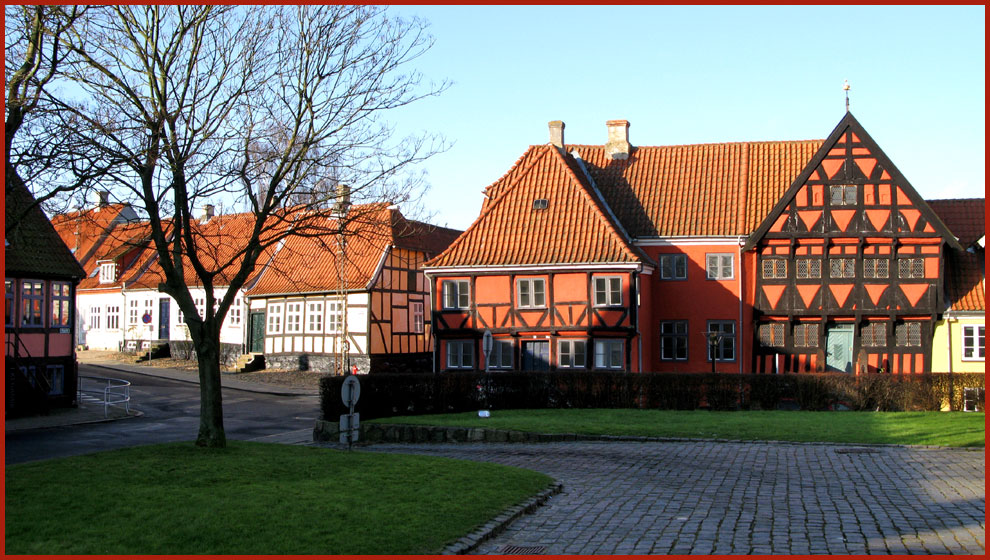
The old part of Middelfart
(Photography by Karsten Petersen)
Above picture does not look
very maritime, but it is taken just above the waterfront which you will
find a few steps away to the to the right in the picture.
But when you read the street
signs, you do get some indications - - - -
The street coming into the
picture from the left is "Knorregade", - "Knorre Street".
The name does not make any
sense in today's language, but if you just change the "o" with an "a",
you will get the name "Knarre Street".
Then the weird name suddenly
makes a lot of sense if you know what a "knar" is.
A "knar" is simply a sort of
viking ship used for carrying cargo.
In other words, - "Knorregade"
was simply the street that leads down to the port area where the "knars"
were once moored - - -
"Knorregade" stops at the crossing
you see on the picture, but actually it continues to the right, - passing
the beautiful red, half-timbered houses -, and ends right at the waterfront,
but now under the name "Brogade" - - -
"Brogade" means "Bridge Street",
- a common street name in Danish port cities -, and it indicates that this
is the street that leads you to the bridge where the ships were moored.
In some other cities the name
"Brogade", - "Bridge Street" -, has actually become "Skibbrogade", - or
"Ship Bridge Street" -, and in those cases you are of course not in doubt
about what sort of bridge the name refers to - - - -
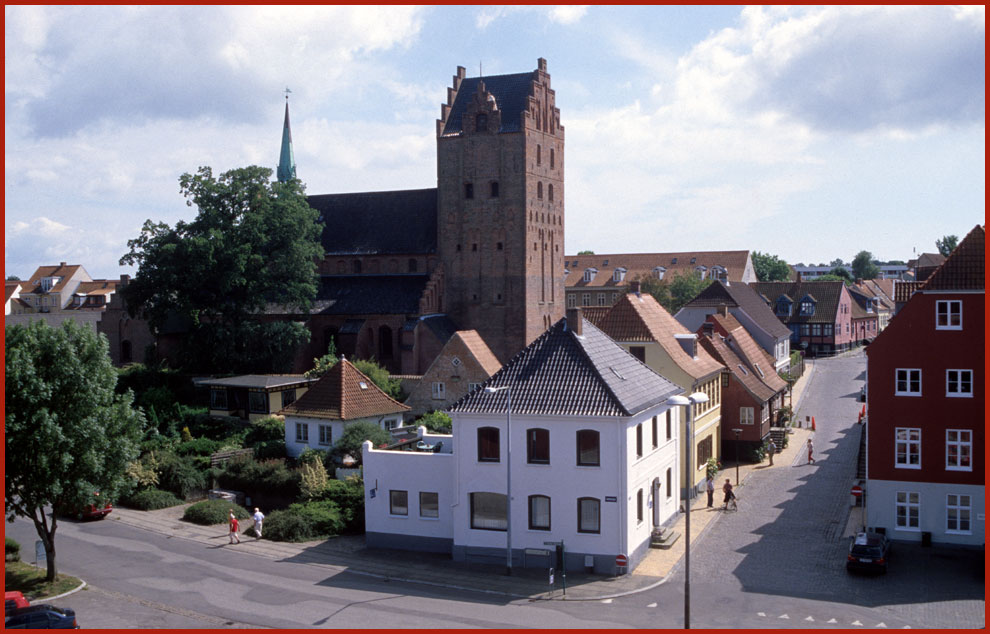
Old Middelfart with a look
along "Brogade" - "Bridge Street"
(Photography by Karsten Petersen)
In this picture you see the
entire "Brogade", - "Bridge Street" -, coming from the city and ending
at the street you partly see in the bottom of the picture.
This street is named "Havnegade"
or "Harbour Street", - and this is exactly what it is because it runs parallel
to the port area which is from where I took the picture.
"Gammel Havn", - or "Old Harbour"-
, is just here where "Brogade" ends - - -
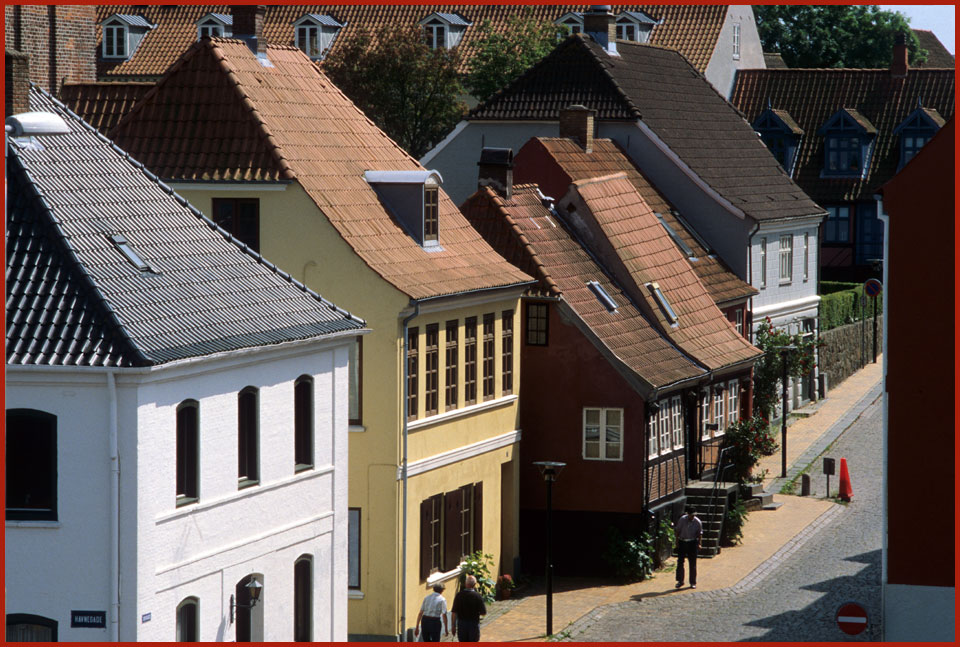
A view along "Brogade" with
it's old, picturesque city houses.
The white house to the left
is the former harbour office
(Photography by Karsten Petersen)
The picture of the middle age
ship which could be seen on the city logo from before Jan.01.2007, can
be found many other places in the old part of the city - - -
(Note: The reason why you cannot anymore
see the historical city logo with the middle age ship and the whale as
shown in the beginning of this page is, that before Jan.01.2007 Denmark
was split up in 16 administrative regions which again was divided into
270 communes, - each with its own distinct logo that symbolized something
typical for that particular city or area.
Taken the very small size of the country
into consideration, this was a mess and a hopeless and expensive
bureaucracy, but finally it was decided to clean up in this waste of resources,
and after Jan.01.2007, the administration came down to only 5 regions split
up in 98 communes.
In this process the former small communes
now came together in fewer, but bigger units, and therefore a lot of the
old city logos had to go, because the new bigger communes were different
from the original ones.
Therefore the new logos had to reflect the
new situation, - and consequently Middelfart had to give up it's wonderful
logo with the middle age ship with the whale underneath , - unfortunately.)
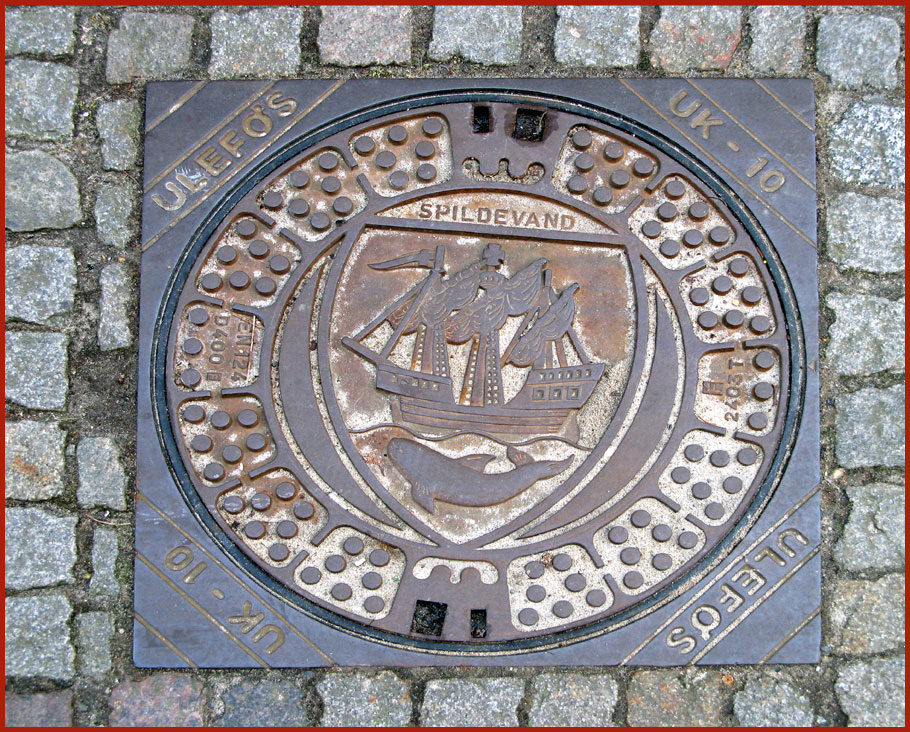
Middle age ship and whale.
Maritime picture on cover for
the city's sewer- and drain system.
Covers with this image can
be found in the old section of the city.
(Photography by Karsten Petersen)
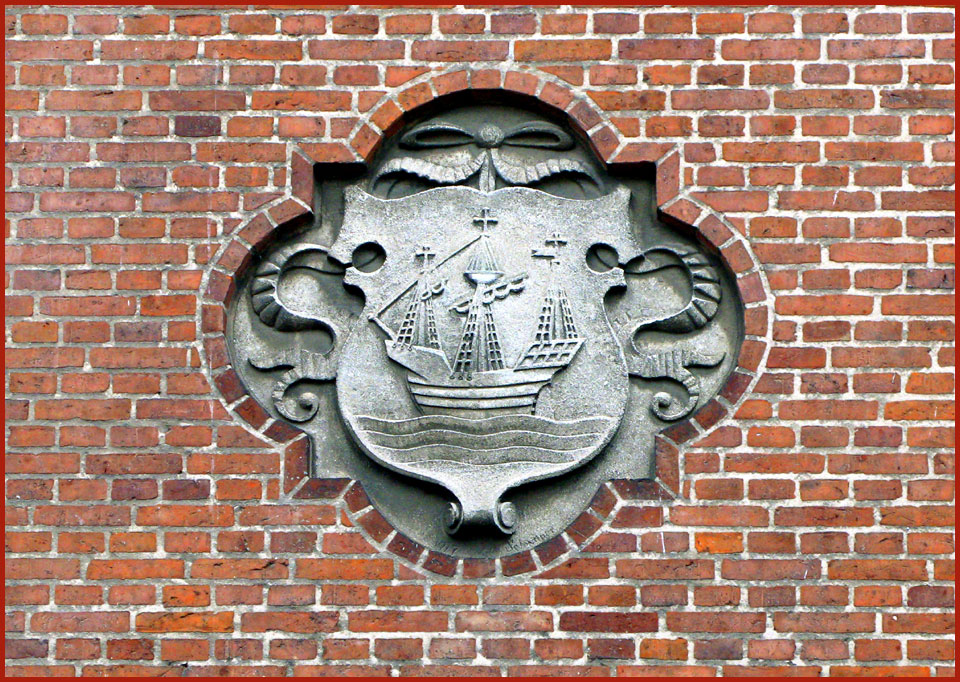
The middle age ship pictured
here on a wall.
(Photography by Karsten Petersen)
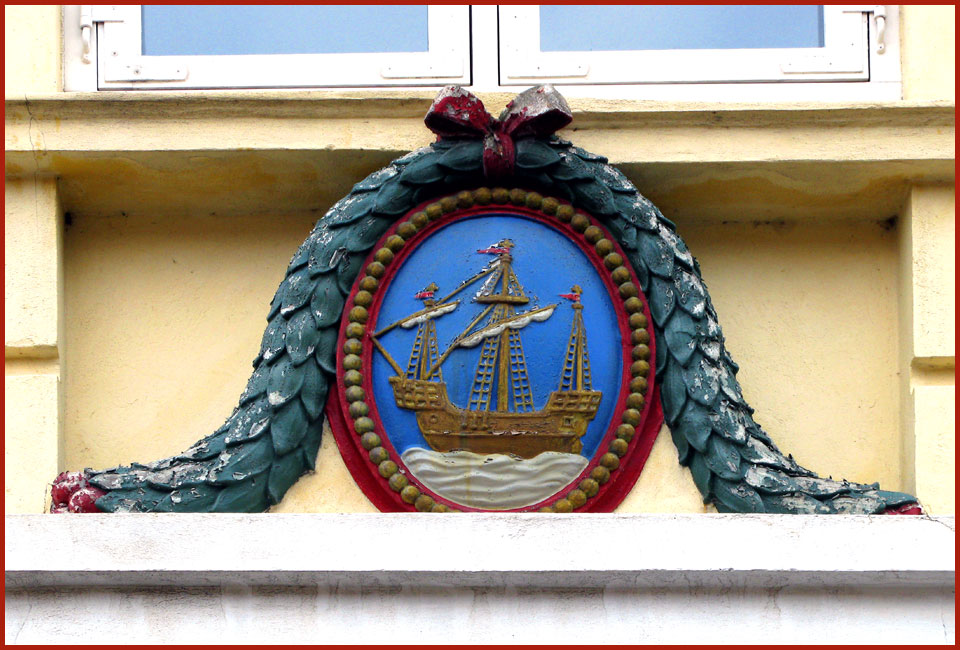
Here another wall decoration
showing the same middle age ship in full colours.
(Photography by Karsten Petersen)
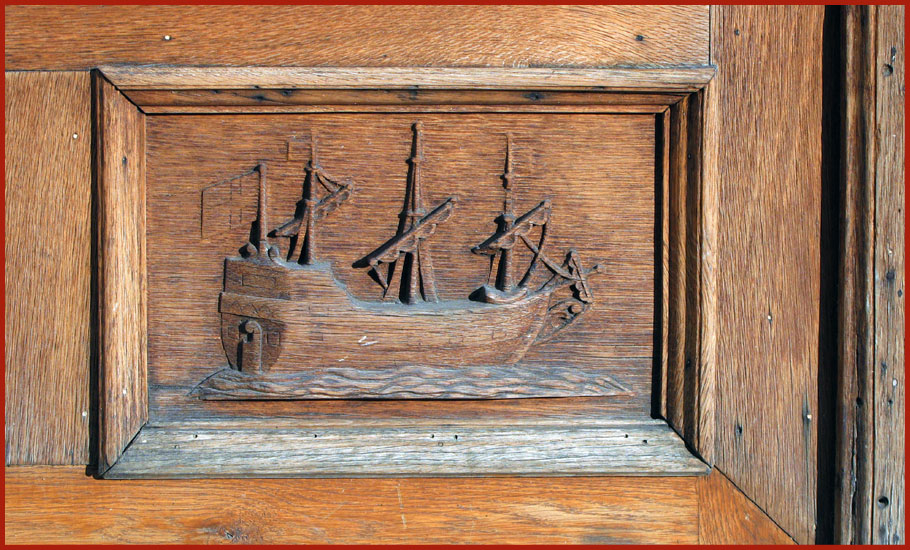
And here is one carved in wood.
This is a section from a gate,
which is obviously not too old, but very likely copied from an older, original
gate.
(Photography by Karsten Petersen)
The picture of this ship seems
to be everywhere, - but where does the inspiration come from????
The "mother" and inspiration
to all those ships pictures might come from the old church in Middelfart.
Above the church entrance you
can see the following stone carving built into the old brick wall.
This stone carving differs
from most of the other pictures, because if you look closely, you can see
that the ship on the church clearly have gun ports.
In other words, - it's a war
ship.
Only the wood carving on the
gate, - as shown above -, has gun ports, while all other pictures I have
displayed on this page show merchant ships - - -
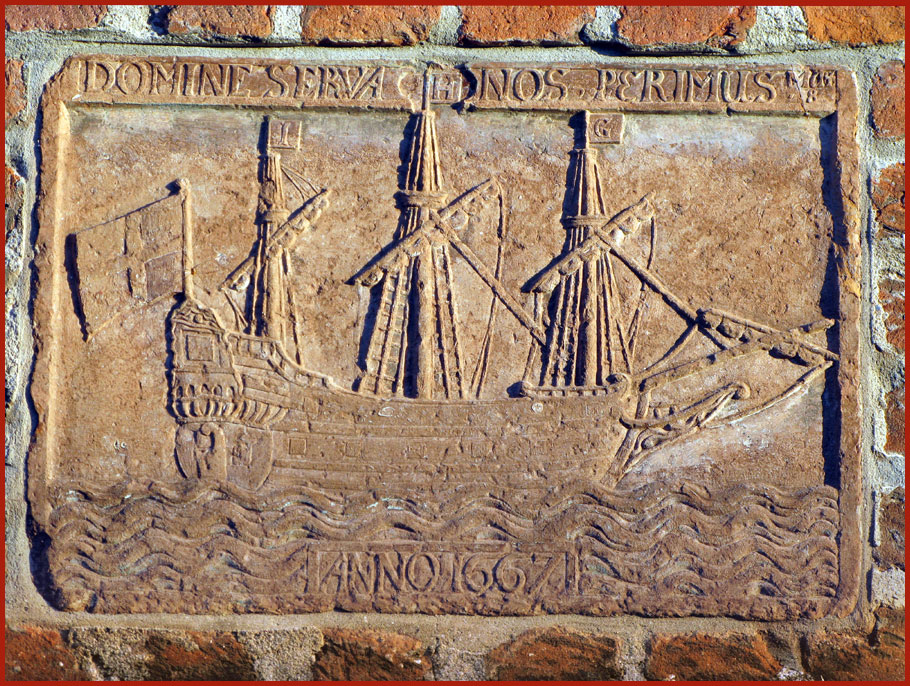
Here the "mother" of all the
Middelfart ship pictures
- a warship carving on the
church dated 1667 -
(Photography by Karsten Petersen)
Now finally some pictures from
"Gammel Havn", - "Old Harbour" -, with it's unique maritime atmosphere
- - - -
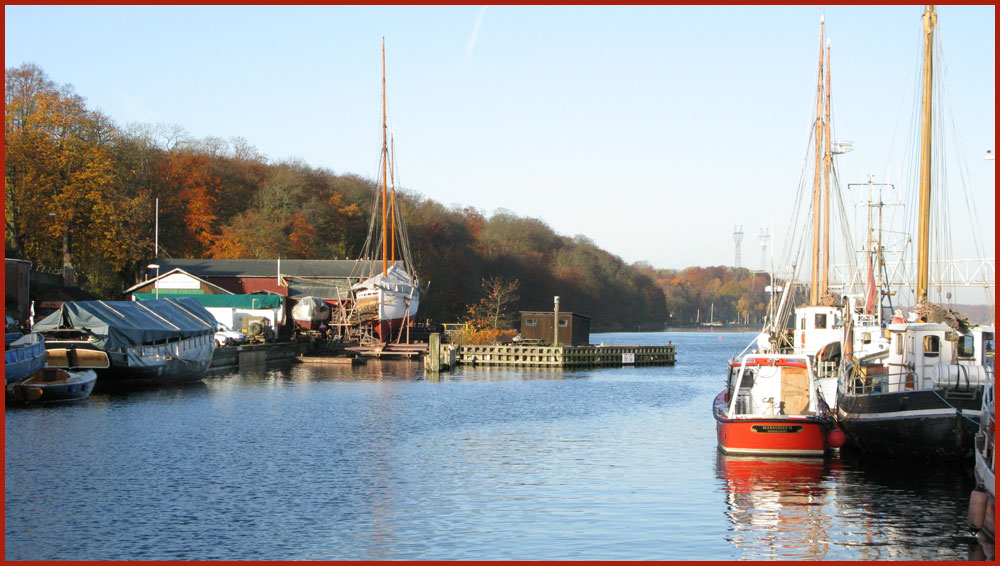
View of "Gammel Havn" - "Old
Harbour"
(Photography by Karsten Petersen)
The picture shows a wonderful
autumn look out of "Gammel Havn, with the historical ship yard, - "Lillebælt-Værftet"
-, in the background.
On the slipway you can see
a traditional sailing ship under repair - - -
To the left you can see the
hull of the cutter "Nordstjernen" from 1872, - the oldest still existing
ship built in Middelfart -, covered by a green tarpaulin, - waiting to
be restored to its original appearance - - -
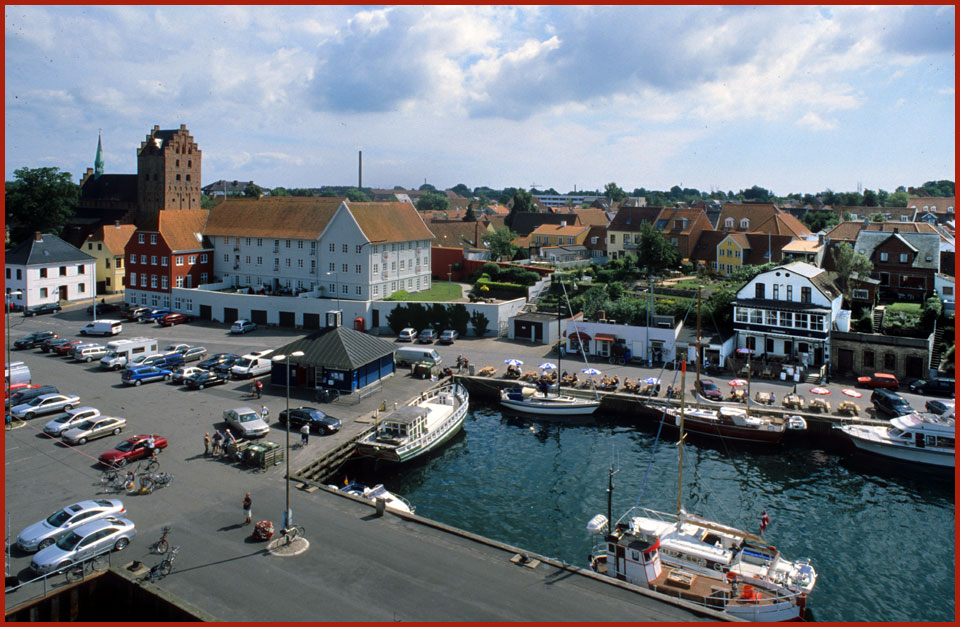
The eastern part of "Gammel
Havn" - "Old Harbour" -, "Brogade" seen to the left.
(Photography by Karsten Petersen)

The central part of "Gammel
Havn"
(Photography by Karsten Petersen)
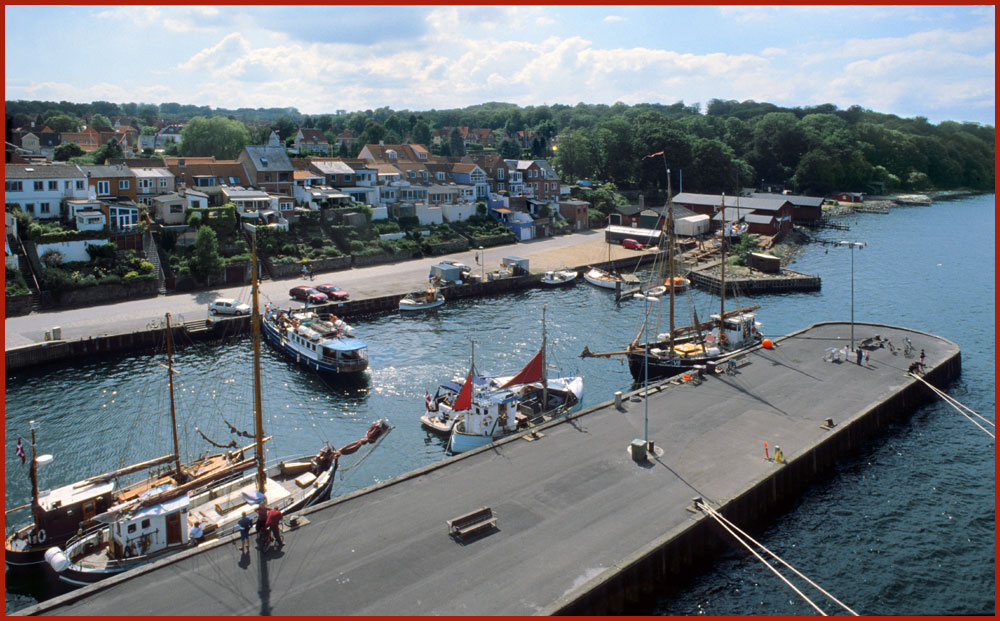
And here the western part of
"Gammel Havn", - "Old harbour"
The historical ship yard where
ships have been built for more than 150 years is seen to the right.
(Photography by Karsten Petersen)
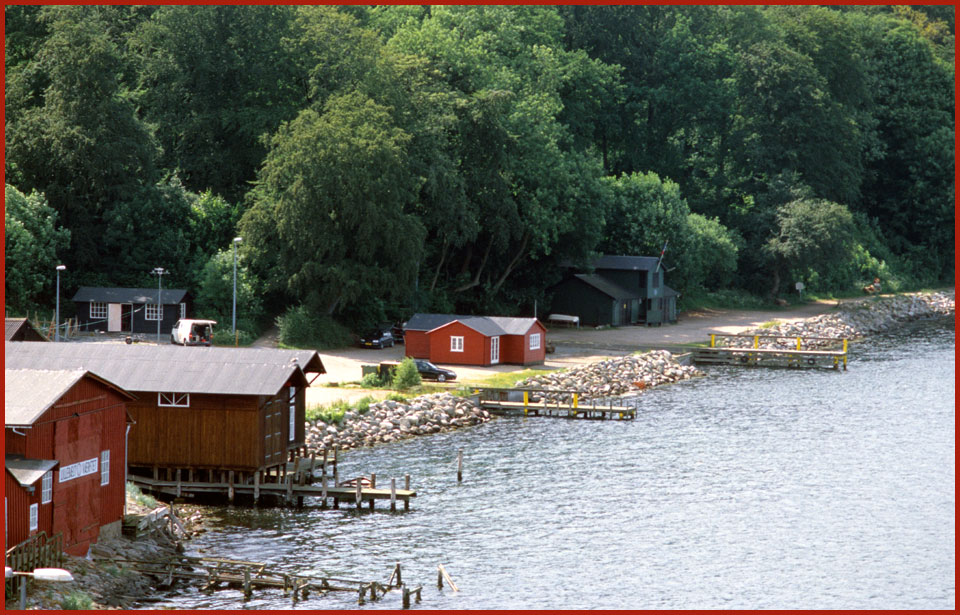
Here a look along the coast
beyond "Gammel Havn"
(Photography by Karsten Petersen)
To the left a small part of
the dark red painted old ship yard can be seen, - then comes the two so
called boat houses,- painted brown -, and in the middle of the picture
you can see the red painted Navy Club, - quite modest compared to the palace
like Navy club in Marstal
, - but it's there, and that is the important thing - - -
The last green painted building
you see behind the Navy Club is the club house of the local divers - -
-
All very maritime things concentrated
on a short stretch of coast line beyond "Gammel Havn.
What you cannot see on this
picture is the area behind the boat houses, where fishermen usually dry
their nets, and also there is a number of picturesque wooden sheds where
fishing gear is stored - - -
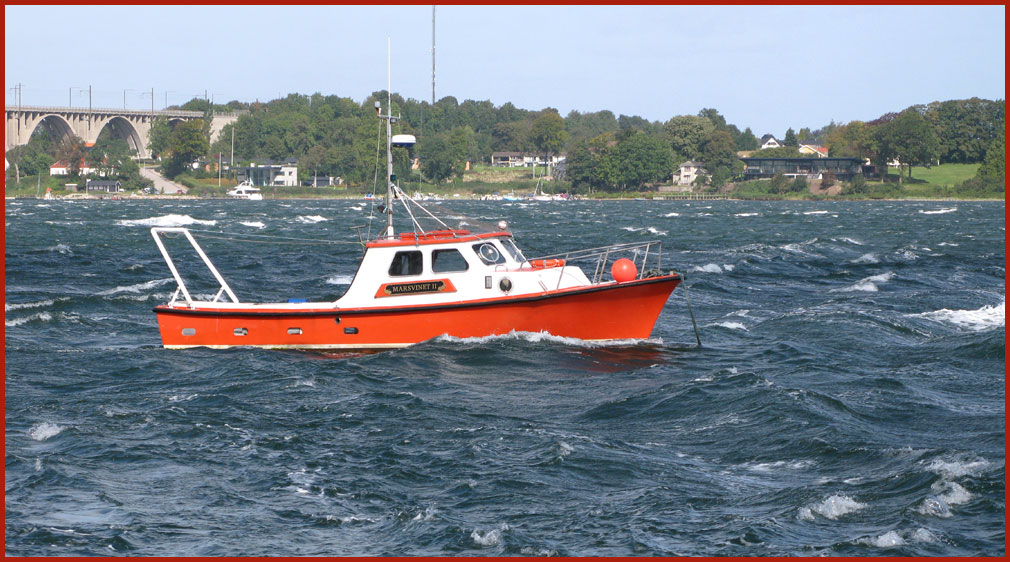
"Marsvinet II"
- the boat of the local diver
club -
- well equipped with underwater
search equipment and a crane beam aft -
(Photography by Karsten Petersen)
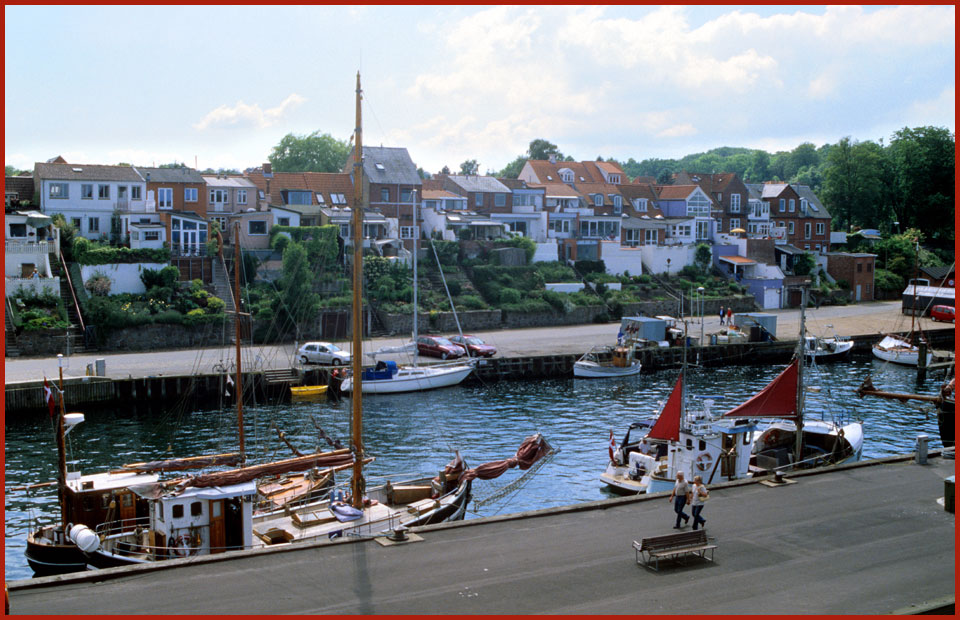
Another view of the central
part of "Gammel havn", - "Old Harbour".
(Photography by Karsten Petersen)
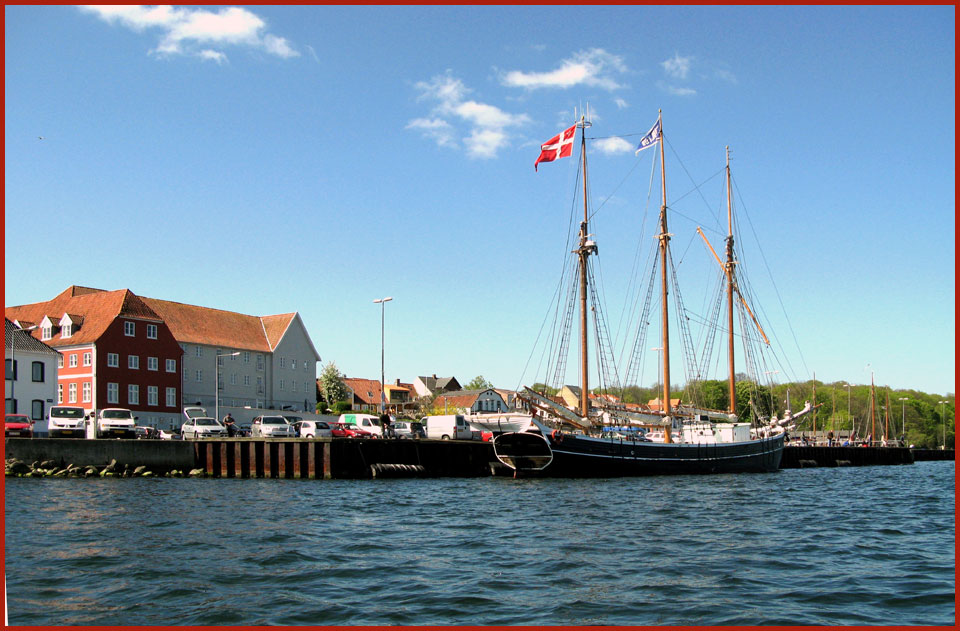
"Gammel Havn"
- here seen from the sea, with
3-mast schooner "Fulton" alongside the outer pier -
(Photography by Karsten Petersen)
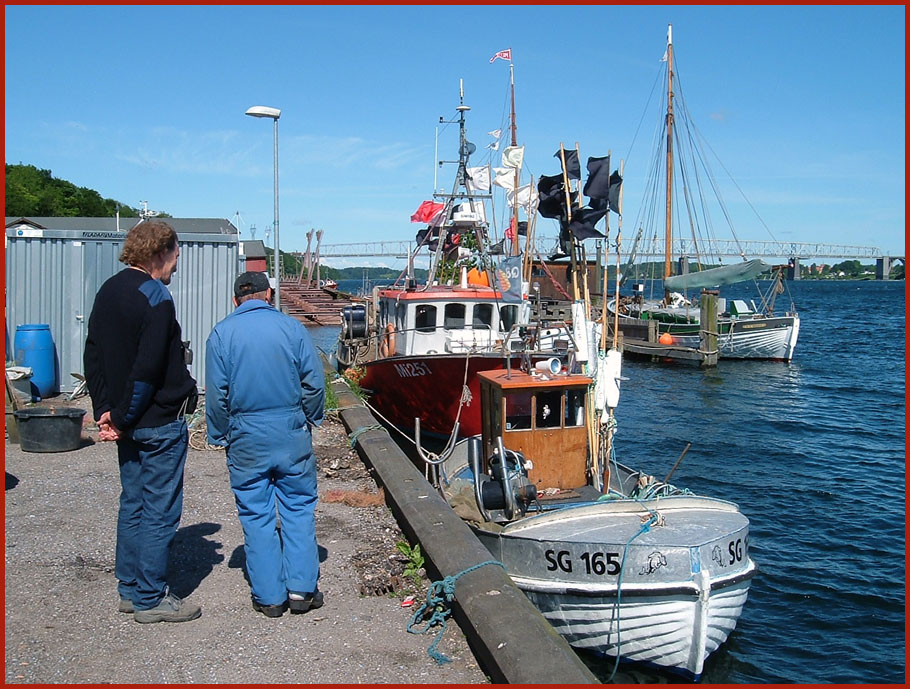
A couple of old deep water
sailors at "Gammel Havn"
- me to the left, and Jan,
- old Far-East-sailor-turned-fisherman-, discussing memories from Hong
Kong -
(Photography by Cesare Battista, Canada)
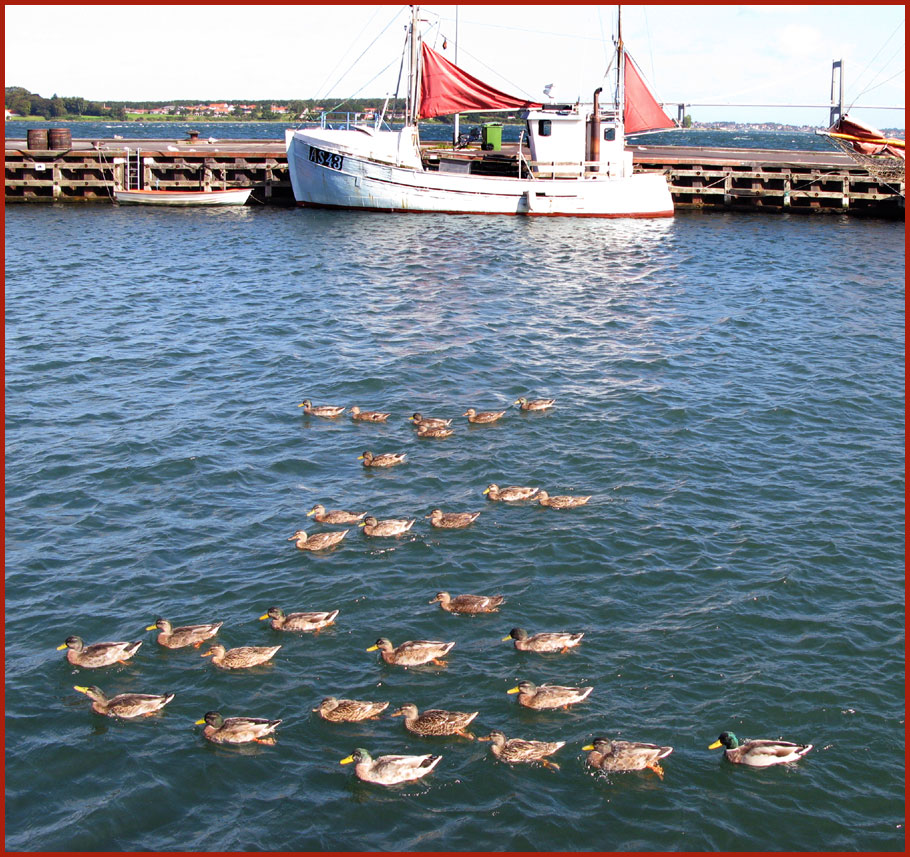
Fishing boat, - and lots of
ducks -, the local inhabitants of Gammel Havn.
(Photography by Karsten Petersen)
--------------------------------------------------------------------------------------------------------------------
Lillebælt-Værftet
- the old, traditional ship
yard -
Now some pictures of the old,
traditional ship yard, - "Lillebælt-Værftet" -, where ships
have been built for more than 150 years, - and are still being built and
maintained to this day - - -
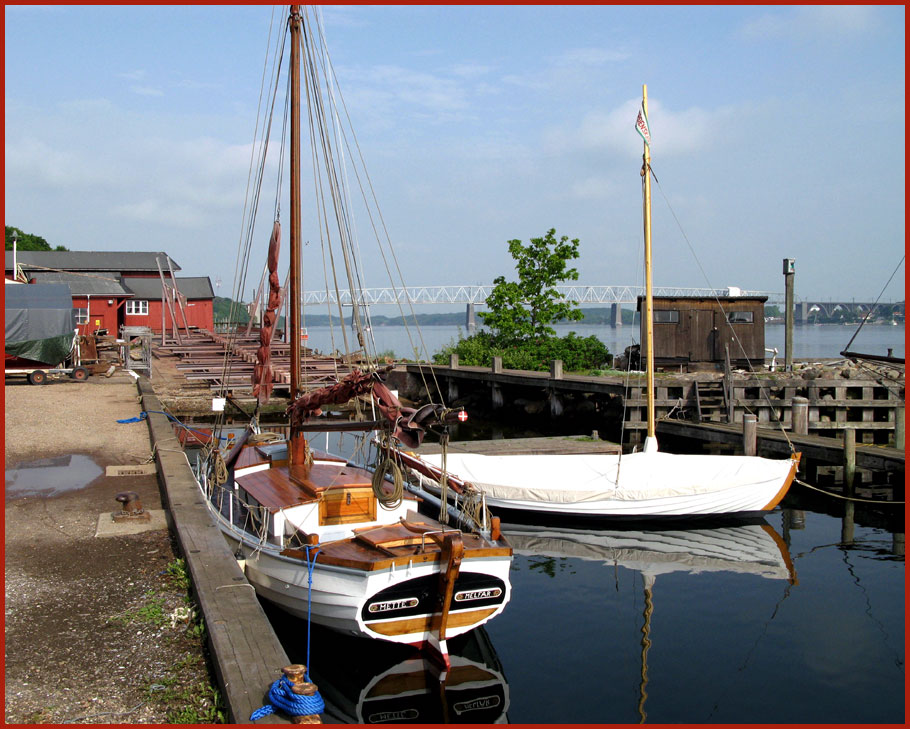
The old ship yard, - "Lillebælt-Værftet"
- here shown with an empty
slipway - and a beautiful traditional boat in the foreground -
(Photography by Karsten Petersen)

"Lillebælt-Værftet"
- the back side of the yard
with piles of oak timber waiting to be cut -
(Photography by Karsten Petersen)
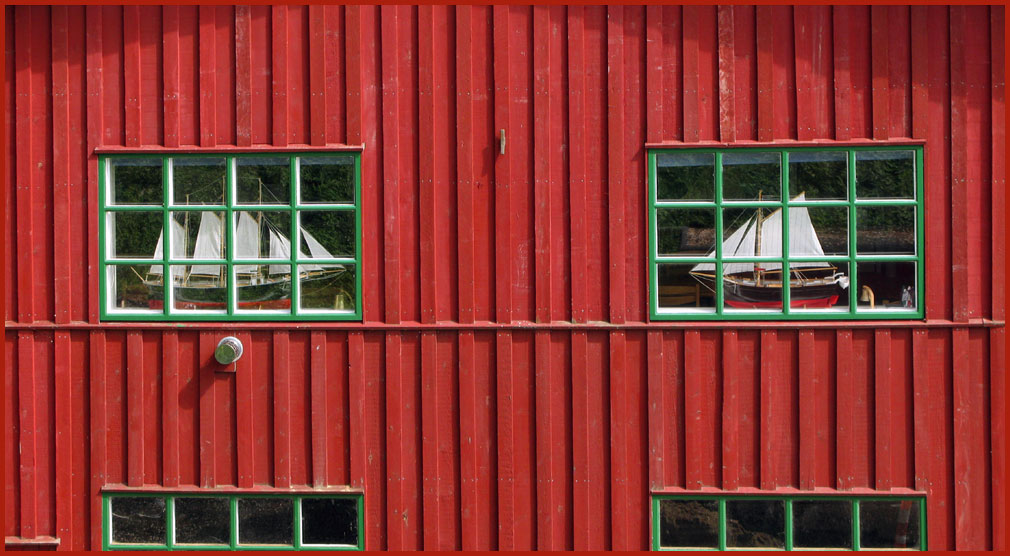
"Lillebælt-Værftet"
- a look through the windows
with models of traditional ships on display -
(Photography by Karsten Petersen)
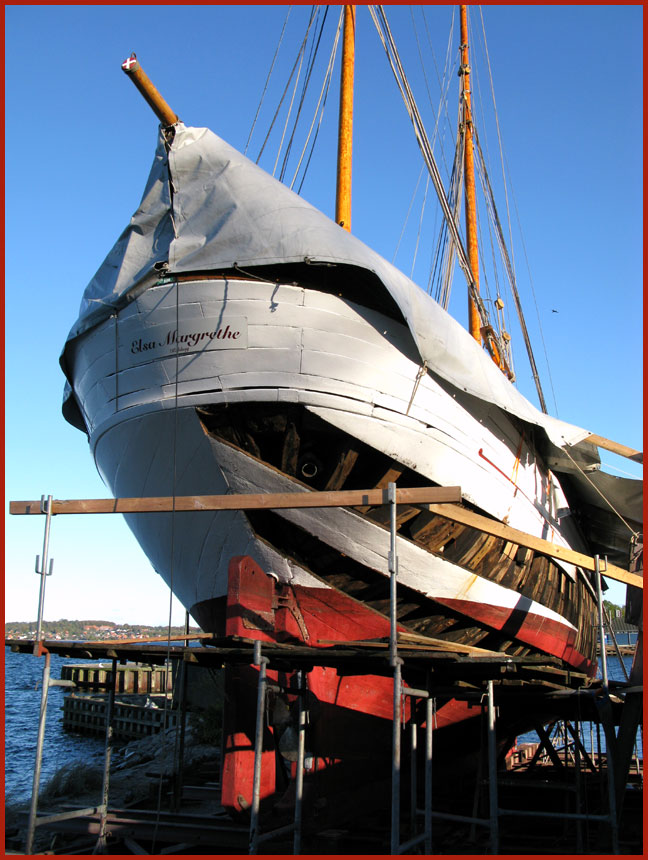
"Elsa Margrethe"
- "Elsa Margrethe" of Kolding
on the slipway for extensive repairs -
(Photography by Karsten Petersen)
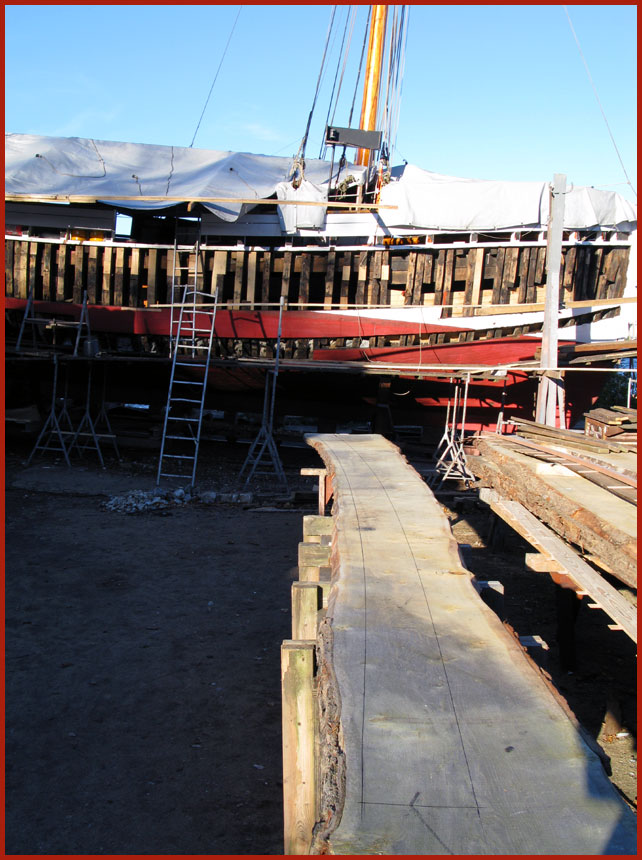
"Elsa Margrethe"
- here the Master Shipbuilder
has accurately outlined the shape of a new hull plank -
(Photography by Karsten Petersen)
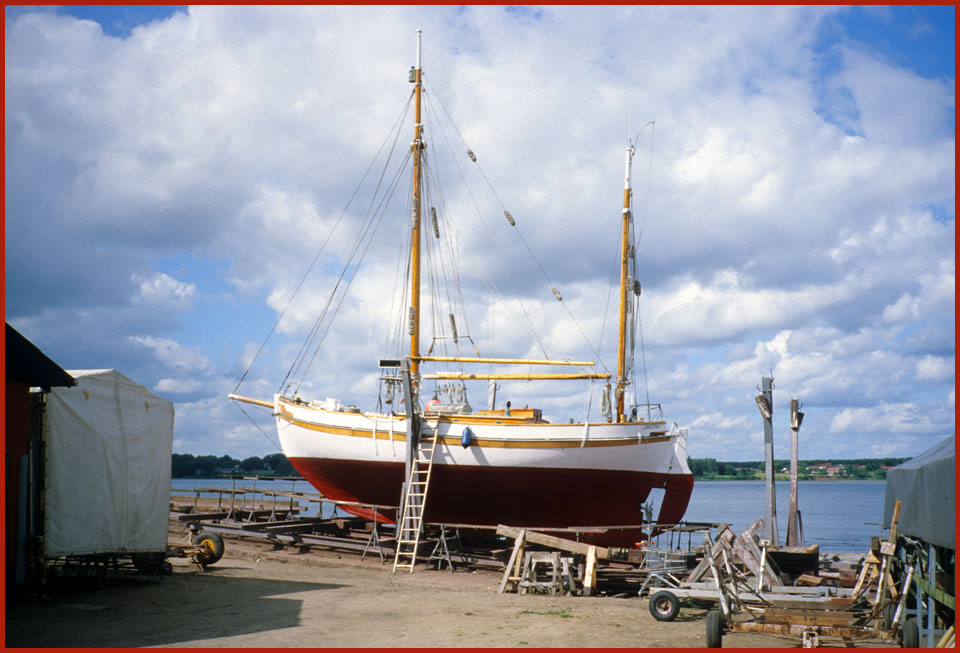
"Christina"
- very often you can see very
beautiful traditional hull lines on the slipway -
(Photography by Karsten Petersen)
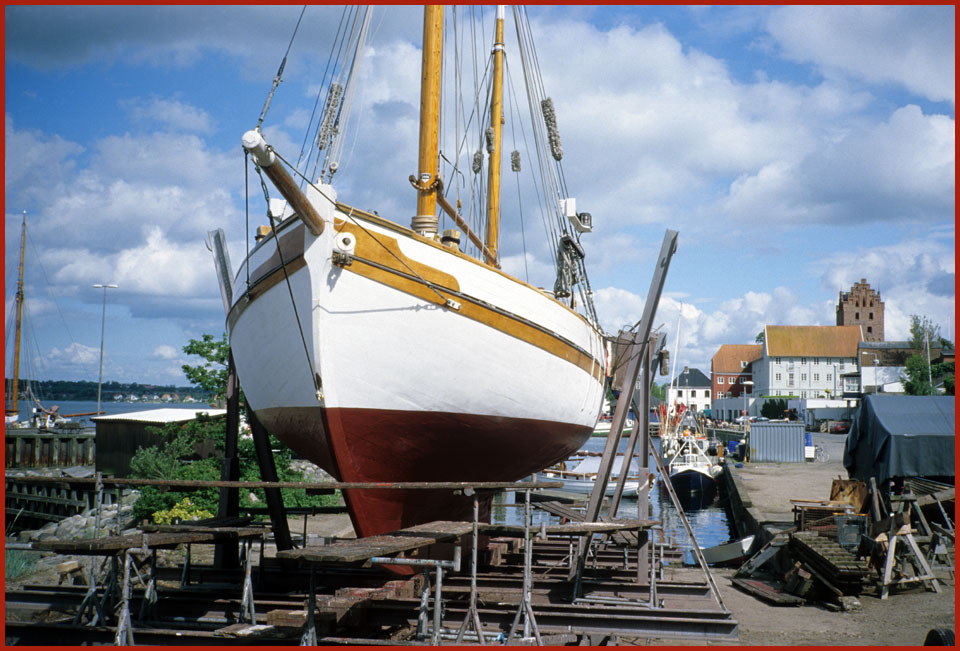
"Christina"
- "Christina" again on the
slipway with her newly painted, perfect traditional hull lines -
"Gammel Havn", - "Old harbour"
-, and Middelfart in the background.
(Photography by Karsten Petersen)
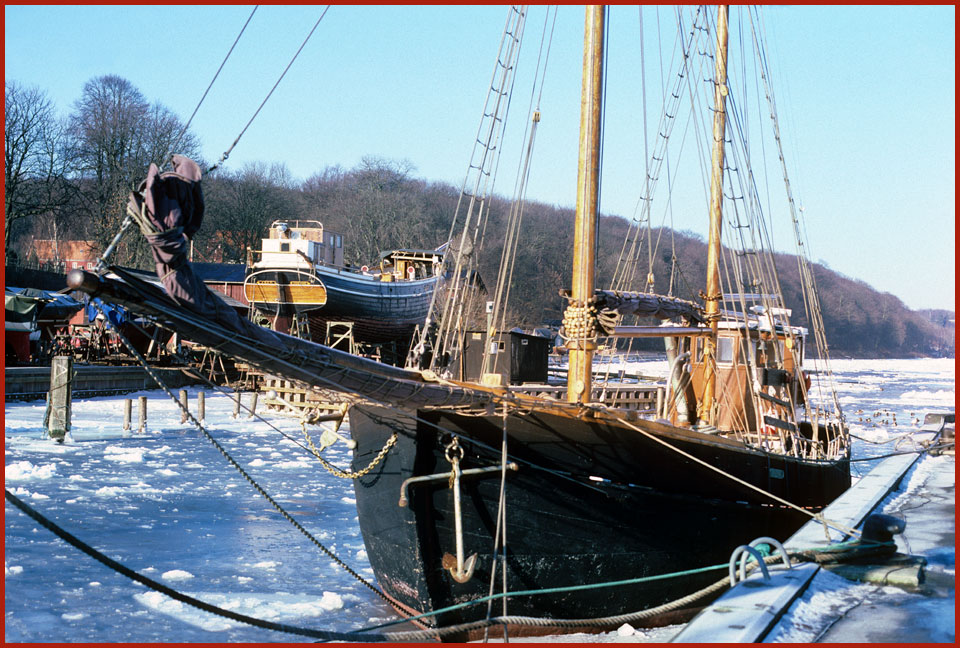
"Gammel Havn" in winter
- the old ship yard, - "Lillebælt-Værftet"
-, in the background -
(Photography by Karsten Petersen)
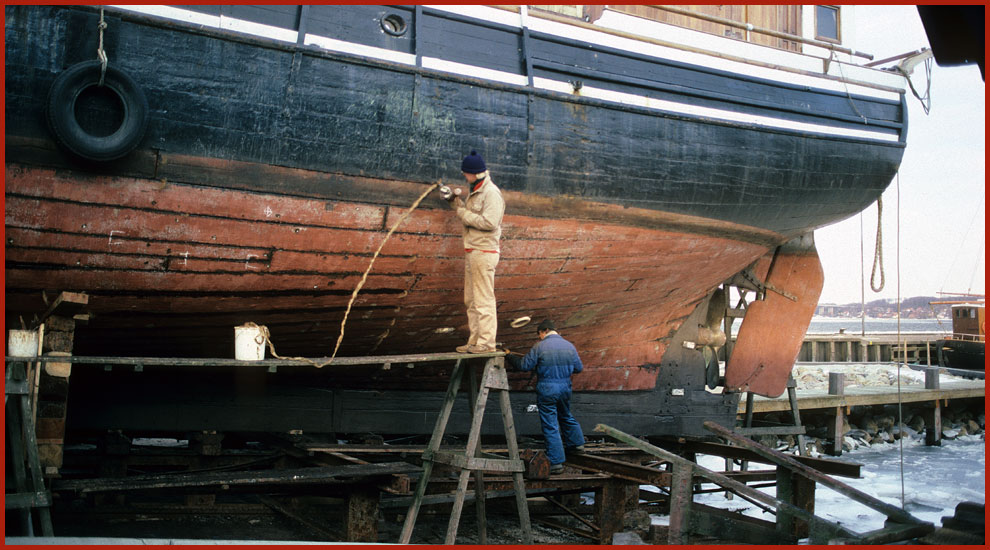
An old-timer, - "Frem" -, being
caulked
- even during winter the caulkers
from the old ship yard work outside in order to keep the old ships in shape
-
(Photography by Karsten Petersen)
"Lillebælt-Værftet"
is not only an old ship yard where traditional wooden ships are being maintained
and repaired, - or new boats being built.
It is also a cultural center
where all sorts of activities take place, - art exibitions, - lectures,
- music events or whatever they find interesting - - -
Then the ship builders clean
the floor for sawdust and tools, and people are invited inside to have
a good time.
Here the band "Sofagruppen"
is giving a song - - - -
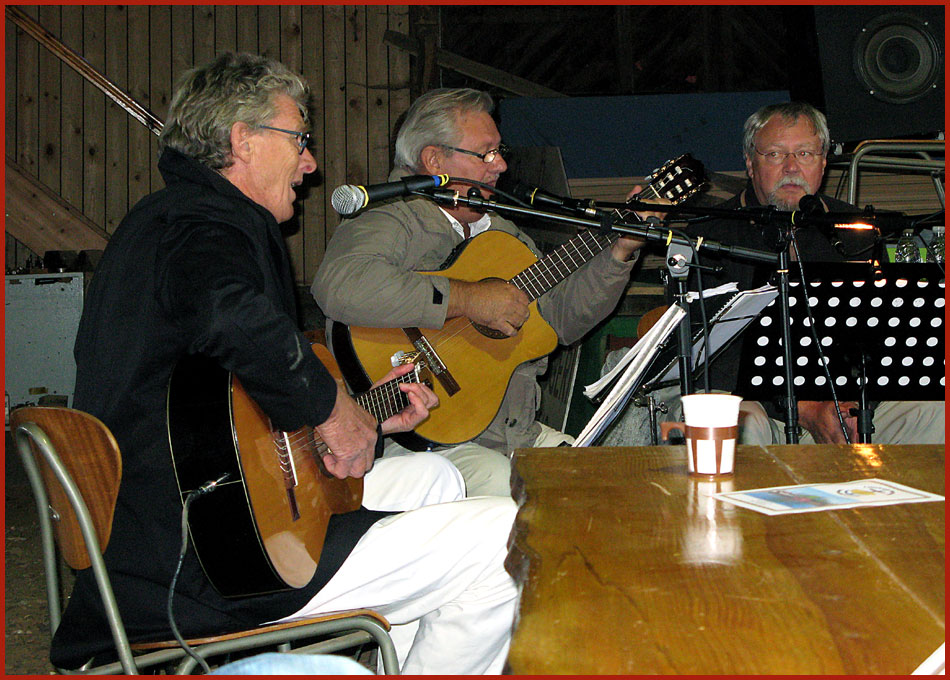
"Sofagruppen" entertains.
(Photography by Karsten Petersen)
Click here for page two about
"Maritime Middelfart"
Back to "The
Ships"
Page initiated: Dec.29.2007
Updated:
Dec.30.2007
Jan.02.2008
Jan.05.2008





























